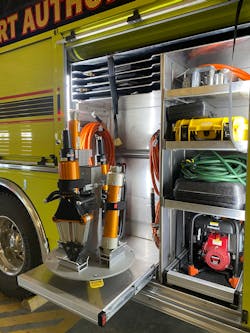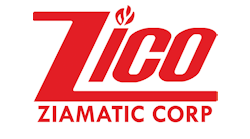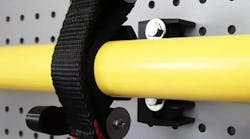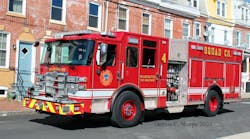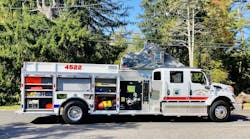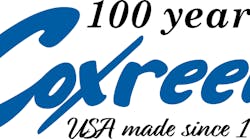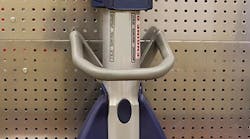During my visits to several fire brigades in Austria, members proudly showcased their apparatus, and I was impressed with the equipment cache that was carried on the smaller European rigs. They certainly were laid out for functionality.
Later, while I visited Rosenbauer’s headquarters in Leonding, Austria, I saw that the manufacturing areas mimicked the new rigs that were rolling out the door—well organized to ensure that each tool, bolt, wire and part were easy to access and to deploy to keep vehicles moving down the production line without delay.
My tour guide, Steve John, who serves as head of special projects, shared how the cooperation between his teams and the fire departments led to the high-functioning apparatus that we saw. He said departments must work with builders from the very start of a project to determine what equipment is going to be stored and where it will be stored, to make sure that a rig is designed for functionality.
Member well-being, access flexibility
Back here in the United States, payloads on fire apparatus are growing, as departments take on more duties while balancing firefighter health and safety through ergonomics in design. That boils down to where and how equipment is mounted and ease of access.
“What it all comes down to is versatility and having multiple options available,” Keith Creely, who is vice president of Ziamatic Corp., says about his customers’ equipment-mounting needs. “We have single mounts, which can be used on 20 different pieces of equipment.
“I think that they’re focusing on outfitting the truck in a way that will help them, but if the truck has equipment or systems that are safer and have less of a chance of having issues, that’s what they are moving toward,” he adds.
Creely shared the following five trends with Firehouse in an exclusive interview.
Electric equipment & tools
Very few fire service product markets are evolving as quickly as battery-powered tools, including saws, extrication equipment, fans and lights.
Recognizing that, Ziamatic expanded its product line, including lazy Susans for extrication tools. For example, the QM-MEH-1 has brackets to hold as many as four extrication tools—including cutters, rams, combination tools and spreaders. Its base is only 23 inches, which gives more space for storage of other tools.
Creely says that the size and weight of the tools have led them to undergo extensive drop testing, to ensure durability and strength for the tools, which often are heavier than hydraulic equipment.
He also adds that, because Ziamatic is an aftermarket manufacturer, its equipment line has to fit most every tool that’s on the market, which led the company to create mounts that can be configured for tools of different dimensions.
Cab and SCBA storage
The Clean Cab concept didn’t stay long in the fire service, but, Creely says, Ziamatic is seeing more departments mount SCBA in body compartments. In response to that trend, the company created the QUIC-SWING and QUIC-SLIDE, which provide horizontal storage of SCBA in compartments. They slide out and swing down, to permit firefighters to easily don their SCBA without extensive lifting and maneuvering.
With more equipment being stored in cabs, departments are looking for mounting solutions to comply with NFPA 1900: Standard for Aircraft Rescue and Firefighting Vehicles, Automotive Fire Apparatus, Wildland Fire Apparatus, and Automotive Ambulances. This requires loose equipment to be mounted or stored in compartments.
Although his company’s universal mounts for helmet storage don’t work on the larger, bulkier European-style helmets that are growing in use, Creely says the company is finishing prototypes that will ensure that the European-style helmets can be stored safely.
Composite materials and nylon straps
Another trend that Creely points to is the growing use of composite materials for mounts. The high-tensile plastics have proven to be strong and durable, and they remove concerns about corrosion and metal-on-metal wear.
“People are accepting the rigidity and the longevity of plastics nowadays. It lasts long. It isn’t breaking or cracking,” Creely says. He adds that the cheap, flimsy prototypes from the ’80s and ’90s were replaced by structurally sound plastic options. During testing, they were put through extreme heat and extreme cold without issue.
During research, Creely says Ziamatic found that the nylon straps that are used to secure hard-suction sleeves on gantries topside weren’t affected by debris. That led the company to use nylon straps on more interior and exterior products. During testing that involved water, heat, UV and dirty environments, the straps stayed engaged with brackets.
Nylon straps have become popular and boast strong retention rates compared with previous materials.
Storage flexibility for change
Creely says that Ziamatic is getting more requests from departments that are adding new equipment to rigs to explore new mounting solutions. Some of these changes are because of new apparatus delivery delays and because response needs have changed, such as adding extrication equipment or new technology.
“The versatility of being able to mount whatever they need and customize the distance or the depth of what they’re mounting is there on all three levels,” Creely tells Firehouse.
He pointed to the company’s SURE-GRIP mount. It’s designed for tools that have a 0.75–2-inch width or a 2–4-inch width. This allows tools to easily be moved without changing mounting hardware or moving a pegboard to accommodate the change.
Slide-outs, trays, drop-downs
Creely says manufacturers of slide-outs and trays also are making it easier for departments to reconfigure compartment layouts and ensuring that pegboards come with a standard 1-inch spacing.
To combat injuries that are sustained during lifting, OnScene Solutions added fold-down gates to its slides and trays, Clay Horst, who is general manager, tells Firehouse.
“You can lift the equipment over the lip, but what happens is, these apparatus are getting taller and taller, and the tray moves up,” Horst explains.
Horst notes tools that are on a tray that’s stored over a wheel as an example.
“You’ve got some piece of heavy equipment, and we have to get it out of that tray,” he says, “which means we’re going to drag it over the edge of the tray, which is potential harm to the tray and the equipment or strain on the firefighter.”
For heavier items, OnScene Solutions’ X-30 Slide can move a piece of equipment, such as a pump, from compartment storage to the ground.
“You’re actually able to drag that equipment onto the ground without lifting it,” Horst says.
End goal: firefighter safety
“What it comes down to is properly mounted equipment prevents workers’ compensation cases and the amount of time firefighters are off, and that equates to money,” Creely says. Moving equipment, after all, can lead to injuries, including sprains, strains, slips and falls.
An injured firefighter can result in medical and overtime costs, and in the case of smaller departments, an injury can remove one vital member from the next call.
